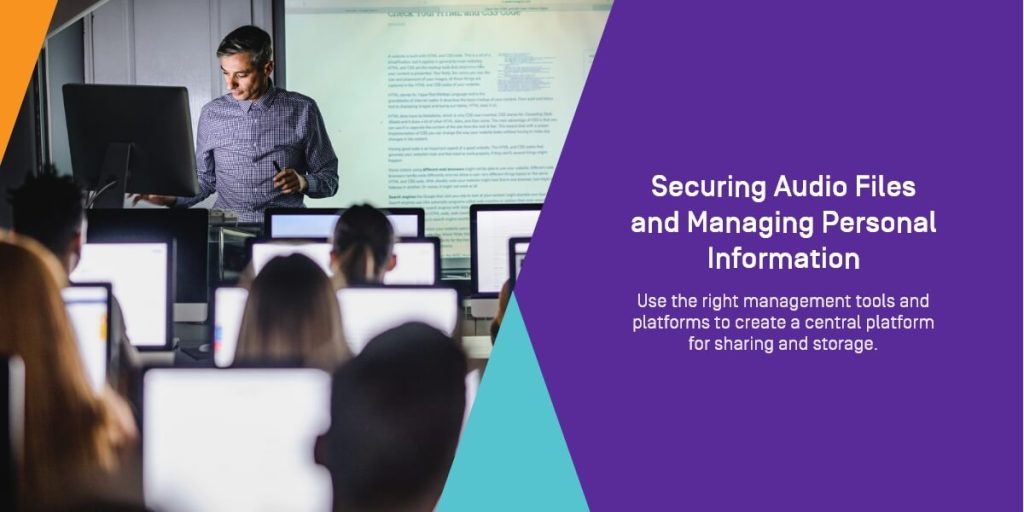
When considering data management in schools, colleges, and universities, many higher education staff members wonder about its effectiveness. In truth, data management strategies can help streamline your file-location needs, assist students and faculty with video and audio data protection, and offer security, compliance, and error reduction at all times. Besides these benefits, using your data management strategies effectively will improve higher education processes.
What Is Data Management?
Data management helps companies and organizations keep track of various formats such as text files, worksheets, audio and video content, and contact and payment data for students and partners. Regarding the business side of using data management, many higher education institutes want to maintain ethical data practices and comply with regulations. Following procedures and policies can ensure proper management and streamlined processes. Data management processes might include data capture, storage, distribution, organization, deletion, security, or replication.
What Are Data Management Strategies?
A data management strategy should create a roadmap your organization can follow. Many higher education institutions want to use their current data to achieve specific goals based on data location, video filing and sharing, or file updates and data retention. A data management strategy helps the organization’s staff work together, share tasks, and efficiently govern data systems.
Data management strategies also work to avoid specific challenges. For example, you might find that your organization often loses certain pieces of data or creates duplicates. Perhaps you struggle to update information, leading to costly and inefficient efforts. Other institutions might have ineffective data strategies that don’t match the long-term goals of the college.
Whatever your institution struggles with, a good data management strategy can create the foundation for successful system integration, increased growth, and improved project tasks.
Why Are Data Management Strategies Important?
Education data management strategies are essential to managing the constant information your organization receives. Creating compelling data management strategies can also help protect your institution’s reputation, organize data and information, and provide better access to information when departments need it.
1. They help you find data sets
Data management strategies can help your organization find data sets for research and program implementation. Finding the right data sets and increasing visibility on data is essential when your institution needs to manage large amounts of student and faculty information. You’ll want the college to be more organized and implement productive strategies to manage data sets. When it is easier to find information, departments can do a better job.
2. They minimize the chance of errors & build trust
Data management strategies can also minimize the chance of errors while helping organizations build trust in the data management system. A reliable plan can ensure you don’t make errors in student information while allowing departments to use data accurately and trust the system.
Many colleges use data to make decisions about institutional improvements, whether physical or internal. With updated, reliable data, your organization can be sure to respond positively to market changes or students’ needs. Without good data management practices, your college might fall into non-compliance, resulting in fines. You might cause reputation damage if you base decisions on errors, or your mistakes might result in profit loss.
3. They offer security & compliance
Data management strategies offer security and compliance for organizations with large amounts of sensitive student and faculty information. The plan protects you and your employees from costly data losses, dangerous thefts, or breaches in the system.
For example, you might make a strategy to use more authentication tools or encryption practices in your system. Perhaps you want to back up more information and make it easily retrievable when needed. Whatever you want to improve, a data management strategy can protect information when required.
4. They keep data up to date & avoid duplication
Data management strategies help your college keep up to date with data and avoid information duplication. Many organizations want to scale their data and usage while ensuring they don’t repeat processes through accidental duplication. Make a strategy to keep your information updated at all times and ensure your operations are easily repeatable.
Types of Data Management in Higher Education
Data management may significantly affect your institution’s organization and planning processes. It can make certain functions easier while allowing employees more time for meaningful work. Some types of data management include:
- Data preparation: Data preparation cleans and transforms data into the correct format for analysis. It can make corrections or combine data sets to assist institutions when handling large amounts of student and faculty information.
- Data pipelines: Data pipelines offer automatic data transfer when moving data across different systems. Data pipelines may be extremely helpful for colleges that often need to update their information with relevant data.
- ETL: Extract, transform, and load (ETL) data management helps institutions retrieve data from one system and convert and upload it to another data system. Many colleges might want to update information or reference information from various platforms.
- Data catalogs: Data catalogs may assist organizations in managing metadata and providing a complete picture of their data sets. Data catalogs help summarize data locations, quality, or changes by making finding data in a centralized location easier.
- Data warehouses: As places where you can consolidate data sources, data warehouses allow organizations to work with stored data types while clearing up pathways for easy data analysis in a centralized location.
- Data governance: Data governance defines the rules, regulations, policies, and procedures for using data management systems. It offers data security when organizations need to protect sensitive student information.
- Data architecture: Data architecture offers a formal approach to managing and creating organized data flow. Many institutions may use data architecture to create easy access to information for various departments.
- Data security: Data security helps your organization protect sensitive data and information. It provides safety and reduces the chances of corruption, hacking, cyberattacks, or unauthorized access.
- Data modeling: Allowing for free-flowing data documentation, data modeling services often come from a different application or outside organization.
8 Data Management Strategies for Higher Education
Here are eight data management strategies for higher education:
1. Document placements & information updates
The first strategy to consider is improving document placements and informational updates. Many colleges must manage large amounts of educational content, from worksheets and coursework to tests and lectures. It can cost time and money to recreate materials constantly. By implementing a document update strategy, your students and faculty can find and update the original documents when needed.
Colleges can use data management strategies to organize and plan for updates to combat potential missing documents or mislabeled items. Make recent versions of documents available and easy to locate while correctly labeling items and saving materials to the right place. When documents are accessible and easy to find, your information will remain updated, and the college can avoid costly errors.
2. Storing video files for easy access
Many faculty members or professors may need access to video files during their time at your institution. For example, professors may use video content to teach students, or staff members may need access to training videos when they begin a job. Whoever needs to use video content, providing easy and quick access to the files can make or break your university’s progress.
As a higher education institute, you are responsible for storing, creating, and managing any videos made to market your college, departments, and resources. Make sure you use an organized video management solution for storage. Have video files available on a centralized platform with easy access for those who need them.
3. Securing audio files & managing personal information
Like video files, your organization may need to organize and secure audio files to protect student and staff information. Many professors, marketing team members, or staff members use audio files when teaching or creating advertising content. For example, you might need to store lesson recordings, video audio files, podcasts, or tutorials.
Storing files incorrectly can lead to file loss, corruption, or poor quality. Some audio files might also contain sensitive data, such as personal names and information. Plan to monitor how you store and secure your audio files closely. Use the right management tools and platforms to create a central platform for sharing and storage.

4. Track & assist students
Make a plan to track all students throughout their time at your institution. From an applicant to graduation, you can follow various students across departments and ensure their data complies with regulations. Allow access to student information, keep staff members accountable, and cater to administrative needs.
By tracking and assisting students with informational needs, you can better identify those who might be struggling. Tracking data can help your organization determine how to intervene and when to provide support. Consider using a data management strategy based on reliable data to reduce dropout rates.
5. Improve online learning
Improving online learning can be an excellent strategy for college institutions. Many colleges and universities have realized the value of flexible schedules, classes, material, and online learning platforms. With the shift to online learning, many institutions have had to rethink their teaching models, meaning more students and teachers have come to appreciate virtual classes and learning materials.
Use your data to assess what online course might be best to offer. You can help students continue with professional education and increase revenue through virtual classes. Many institutions provide their popular general education classes in online formats to increase attendance.
Improving online learning may look like this:
- Outreach tracking: Reach out to the community or track student participation.
- Real-time access: Online classes can provide real-time access to courses and material.
- Portal access improvement: Improve student access to online portals and essential college resources.
- Career opportunities: Online opportunities make identifying career opportunities or degree completion steps easier.
6. Improve outreach
Using a data system can help your organization improve outreach strategies. Because many colleges contain large amounts of data and information about faculty, students, alums, and donors, creating a cohesive and centralized place where you can accurately manage outreach data is essential.
Your institution can improve outreach practices by finding information from a centralized platform, and simply searching using an ID number. You can also prevent duplicates through organized practices and provide reliable data that marketing and communications teams can use for outreach strategies.
Many organizations will benefit from managing data along with fundraising and donor outreach. You can improve data records while reliably migrating data between systems. When improving outreach, your data system can help you keep accurate and updated alum addresses and information records, reduce the chance of duplicates, and maintain records in real time.
7. Work toward compliance
Complying with data system rules and regulations can help your organization improve its strategies. For example, protecting data during migration from old systems or between different methods may result in data governance requirements. Cyberattacks have increased throughout the years, making protecting your data systems’ personal and organizational information essential.
Your institution can use reliable tools to ensure data governance when working toward compliance. Research what rules and regulations apply to your organization and comply with data privacy laws. For example, the college might need to protect student health information. You should also use proper codification and practices to protect sensitive information, such as data masking, security-based roles, fraud reduction, and anonymization.
8. Reporting & managing staff data
Create and implement better reporting and managing strategies using staff and faculty data. Ensure you take information from all departments, including but not limited to financial aid, diversity and equity, marketing, admissions, accounting, and resident life.
When managing faculty information, it can be hard to keep track of relevant data when using multiple systems across different departments or confusing excel reports. By using a centralized data system, you can better combine information and organize your processes. When reporting and managing faculty data, ensure your strategies include the following efforts:
- Simple tools: Easy tools allow faculty to make changes to information whenever they need to.
- Data integration: Create fast and easy data integration through organized maintenance templates.
- Reporting tools: Use reporting tools to track your financial, academic, and operational health in one space.
How to Prioritize Data Management in Higher Education
Prioritizing data management strategies in higher education can be pivotal to the success of your institution. By showing that you care about the files and data of students and faculty, your college or university can better handle large amounts of information and make reliable decisions.
Here are a few ways to prioritize data management:
- Start with priorities: With so much data in your system, knowing what goals to set can be difficult. Have each department choose a focus and stick with it until they reach their destination.
- Use baseline metrics: Establish where your organization is at and set a context for your continued growth as a higher education institution.
- Ask leadership: Make sure the top leadership at your institution is on board.
- Define expectations: Ensure your organization clearly defines the expectations for data and information, including what departments have access, who will leverage data, and how data will improve student, alum, and faculty experiences.
- Make decisions on data: Many organizations make institutional decisions based on experiences, personal choices, or traditional practices. However, with the help of data management, your college can use data to make informed decisions.
- Commit to the long haul: Prioritizing data management will take time. Make sure you maintain patience and persistence throughout the process.
Implement Data Management Strategies With Watermark
Watermark has over 20 years of experience providing data collection services, analysis software, and measurement operations for higher education institutions. Whether you are a community college or a university, we can help you develop and implement new strategies to use your data to improve learning outcomes, research, planning, and accreditation. Contact us today to speak to a representative, or request a demonstration.















































































































































































































































































































































































































